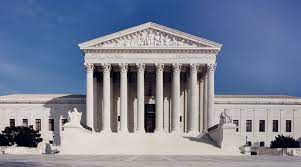How clear are these opening words of the First Amendment: “Congress shall make no law respecting an establishment of religion, or prohibiting the free exercise thereof”?
Judging by the U.S. Supreme Court’s many ventures into this area, we’d have to say not very clear at all. There’s a lesson in that. Constitutions don’t interpret themselves. People do, and the line between interpreting and making law is not as bright as we’re told.
The latest Court decision in the matter, Carson v. Makin, is instructive in that regard. The 6-3 decision — Republican appointees made up the majority, Democratic appointees the minority — struck down Maine’s exclusion of religious schools from a program that provides tax-funded tuition assistance to all parents who live in school districts that do not provide “free, public” secondary education. That’s over half the districts. Maine, according to the Court, is the most rural state in the country. Who knew?
Under the program, those parents can spend the money at another district’s school or at an academically accredited “nonsectarian” private school. The plaintiffs, two families, argued that this restriction violates both the Free-exercise clause and the establishment clause of the First Amendment, along with the Equal Protection Clause of the Fourteenth Amendment. The U.S. district and appellate courts had sided with the state.
The six justices of the majority held that the exclusion of sectarian schools violated the guarantee of the free exercise of religion despite the fact that religion permeated the regular curriculum. (Remember, these were state-approved schools academically.) But the minority justices said the exclusion violated the prohibition on the establishment of religion because the money would go to schools that used it to teach their particular faiths. It was establishment clause v. free-exercise clause.
So who is right? Can that question be answered? Chief Justice John Roberts’s majority opinion and the dissenting opinions by retiring Justice Stephen Breyer and Justice Sonia Sotomayor point to many Court precedents that seem to support their conflicting positions. But the precedents aren’t much help because one can always say that an earlier case differed in an important way from the current one.
Leaving aside one’s background philosophy, all of the arguments seem plausible and consistent with the constitutional text. One might appeal to historical materials, but my hunch is you can find disagreements there too. There’s a lesson in all this, one captured by legal scholar John Hasnas in “The Myth of the Rule of Law.” (A discussion of Hasnas’s paper is here.)
Hasnas’s point is that considering how statutes and constitutions are written and the contradictory case law, judges and lawyers can start at Point A and reach virtually whatever destination they wish. Each individual’s compass will be ideological. This, Hasnas insists, is not the notion of the rule of law taught in grade school or law school, but the rule of men and women. He writes:
The fact is that there is no such thing as a government of law and not people. The law is an amalgam of contradictory rules and counter-rules expressed in inherently vague language that can yield a legitimate legal argument for any desired conclusion. For this reason, as long as the law remains a state monopoly, it will always reflect the political ideology of those invested with decisionmaking power. [Emphasis added. Hasnas favors judicial competition, or polycentric law.]
So what are we to make of the ruling? I’ll cut to the chase before doubling back. Consistent with Hasnas’s thesis, both the majority and the minority think its path is consistent with a desired religious neutrality. The majority holds that neutrality lies in not excluding religious schools from Maine’s program because all eligible parents would be treated the same, while the minority holds that neutrality requires excluding religious schools.
Truth be told, I prefer the ruling to the Court’s alternative, but let’s get clear on some preliminaries first. The root of the conflict that produced this case is government schooling itself. Ironically, the early government-school movement presented the misnamed “public school” as the way to prevent conflict over religion. How’s that worked out, Horace Mann? (See my book Separating School and State: How to Liberate America’s Families.)
Simply put, any government involvement in education infringes the liberty not only of parents but also of nonparent taxpayers, who are forced to support the government’s schools. And let’s be specific: government involvement violates freedom of conscience and not just material property rights. Even before the dawn of wokeness, many taxpayers disliked how the government schools taught even unobjectionable subjects.
The case against government schooling is bolstered by the well-known fact that coercive monopolies are inherently bad deals. They deliver poor quality at unnecessarily high prices. As bureaucratic organizations, they are interested in preserving their perks rather than serving their ostensible “customers.”
So it’s no coincidence that the government’s schools are rotten; the more marginalized the community, the more rotten they are. This is a disgrace because the education establishment has sabotaged poorer people, many of whom suffer the legacy of long-standing official injustices, and kept them from ensuring better lives for their children. If you want to understand intergenerational poverty and cultural shortcomings, think “public schools.”
What we should strive for, then, is parental free choice in a competitive education marketplace. Competition is the universal solvent. (James Tooley and Pauline Dixon, among others, have demolished the claim that poorer people would be worse off in a free education market.)
As more people have come to understand the benefits of free choice, they have proposed steps by which parents could take their kids out of the rotten system. Unfortunately but understandably, reformers have supported incremental changes that still left the state and local governments with a huge amount of power over schooling. I say “understandably” because a proposal to replace government schooling with a free and competitive marketplace (which would include nonprofit institutions) is a hard sell in the current context, although it may be getting easier. One objection to the incremental approach, besides continued government compulsion, is that the radical approach would be shelved in favor of the more-attainable program.
At any rate, various programs — vouchers, tuition tax credits, third-party scholarship tax credits — were set up to help parents escape to some extent the clutches of the school bureaucracy. The Maine program was different because it was only for children living in school districts without secondary schools. In effect, the state told parents they could take the money that would have been spent on a local high school and use it at the accredited school of their choice. The only restriction aside from its being state-accredited was that it be nonsectarian. That seems unfair to religious parents, who regard their religious faith as integral to their education even in secular subjects. Why should they be taxed to support a system they disapprove of?
That’s why I prefer the ruling to what the dissenters wanted. They think that allowing parents to buy education from schools that will “use public money for religious purposes” violates the establishment clause. That strikes me as the weaker argument. How does letting parents have that choice “establish” religion? Maine did not set up a state church.
It all depends on how one interprets that clause. (This problem plagues the Constitution. See my America’s Counter-Revolution: The Constitution Revisited.) In his dissent Breyer says there is “play in the joints” between the establishment and free-exercise clauses, leaving “wiggle room” in which states can “navigate the tension created by the Clauses and consider their own interests in light of the Clauses’ competing prohibitions.” Loose joints and wiggle room hardly provide good guides for legislative dos and don’ts. Roberts counters that a “State’s antiestablishment interest does not justify enactments that exclude some members of the community from an otherwise generally available public benefit because of their religious exercise.” I think that makes more sense.
Breyer writes, “Maine thus excludes schools from its tuition program not because of the schools’ religious character but because the schools will use the funds to teach and promote religious ideals.” That supposed distinction enables him to embrace earlier decisions that permitted tax money for religiously affiliated institutions, but is that distinction meaningful? Can there really be a church-affiliated school that does not promote its faith to the pupils? The state legislature thought so and in theory permitted parents to spend the money on the former sort but not the latter sort. That sounds more like a word game to protect its statute from court scrutiny. The Court majority didn’t buy it.
My arguments here assume the existing political context, which of course I want to see changed. As long as state schools, state curriculum requirements, and compulsory attendance exist, fairness requires that parents — who pay income taxes, sales taxes, and property taxes one way or another — be free to direct the money to the schools of their choice. “School choice” is a pale substitute for real freedom, and it will always come with unjustifiable conditions, but it still may provide children an exit from intolerable situations.
If we must err, let’s err on the side of the parents’ freedom of choice. Let’s face it: the taxpayers would be coerced to support something they disapprove of no matter the outcome of this case, a point overlooked by the dissenters, who are concerned only when people are forced to support religion.
Let’s also push, then, for a wider freedom of choice. No one should be forced to finance schools (or anything else for that matter). Taxation taints everything. The right to choose is far more radical than most people think.
In sum, it is entirely reasonable to disagree with Justice Sotomayor, who wrote in her own dissenting opinion that the majority in this case “continues to dismantle the wall of separation between church and state that the Framers fought to build.” The First Amendment doesn’t mandate a “wall of separation.” (Jefferson most famously used this metaphor in a letter.) Rather, it seems to say only that Congress may neither establish religion (as, say, in England) nor interfere with anyone’s free exercise thereof. The Court long ago applied this and other applicable provisions of the Bill of Rights to the states via the 14th Amendment. (The establishment clause originally also meant that Congress couldn’t interfere with the established churches in individual states at the time.)
It’s hard to see how Maine has either established religion or interfered with its free exercise merely by “giving money to parents” (Sotomayor’s words) that they can freely spend on schooling. Contrary to Sotomayor, the ruling does not “require[] States in many circumstances to subsidize religious indoctrination with taxpayer dollars” because Maine did not have to set up a tuition-assistance program. The ruling simply says, echoing an earlier case, that if a state does so, it cannot forbid parents from choosing schools that mix religion with their regular curriculums. In other words, all it does is let parents spend the money that would otherwise have gone to a government school at the accredited schools of their choice.
Sotomayor also writes: “If a State cannot offer subsidies to its citizens without being required to fund religious exercise, any State that values its historic antiestablishment interests more than this Court does will have to curtail the support it offers to its citizens.” I ask: so what’s wrong with that? Government has no business subsidizing people. If it wants them to have more money, cut and abolish taxes.
































